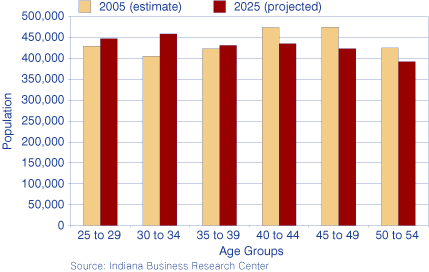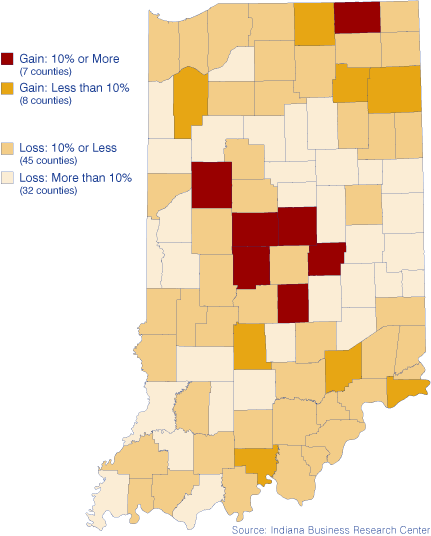Workers Needed: Please Apply by 2025
The Changing 25-to-54 Age Group
People between the ages of 25 and 54 are in their prime earning years and serve as an important labor force demographic—a demographic that is expected to change as the baby boomers age. Using the recently released population projections from the Indiana Business Research Center, (1) we'll look more closely at how this key component of the workforce is expected to either grow or decline between 2005 and 2025 within Indiana's counties.
Currently, the largest segment of Indiana's 25-to-54 demographic consists of 45- to 49-year-olds. However, by 2025, today's teenagers (age 13 to 17 in 2008) will be between 30 and 34 years old and will make up the largest portion of the 25-to-54 age group (see Figure 1).
Figure 1: Indiana Population by Selected Age Group, 2005 and 2025

Indiana is projected to have 2.6 million people age 25 to 54 by the year 2025—a 1.7 percent decline from 2005 levels. This is actually a rather modest decline given what we know about the aging baby boomers. But this change varies dramatically depending where in Indiana one looks.
Figure 2 illustrates county-level change between 2005 and 2025 in the number of 25- to 54-year-olds. Seven counties will see this age group increase 10 percent or more. Hamilton and Hendricks counties will experience the largest rate of change, with increases of 49 percent and 37 percent, respectively.
Figure 2: Change in Population Age 25 to 54, 2005 to 2025

Click for larger, more detailed image
Most of the state, however, will not be as fortunate. Thirty-two counties (predominately rural in nature) will see their population between 25 and 54 years old decline more than 10 percent between 2005 and 2025. Rush, Martin and Benton counties fare the worst on this measure, with projected declines exceeding 20 percent.
One should point out, however, that although 15 counties will see an increase in the number of people in the 25-to-54 age group, virtually all counties will have a lower percentage of their population in the 25-to-54 demographic by 2025 compared to 2005. This will occur because other age groups will grow at an even faster rate. The exceptions are Monroe and Tippecanoe counties, whose 25-to-54 age group will remain stable because of the influences of Indiana University and Purdue University, respectively.
How Does Indiana Compare?
With the anticipated mass exodus of baby boomers from the national labor force in coming years, it would behoove us to put these numbers in context. To do so, we will use state-level population projections from the U.S. Census Bureau; even though the time frame and projections are slightly different than those referenced above, this will allow us to compare apples to apples as we look at what's happening in other states.
Based on Census 2000, the Census Bureau projects Indiana will have 2,535,146 people in the 25-to-54 demographic by 2025—a 2.8 percent decline from 2000 levels. That rate of change places Indiana in the middle of the pack nationwide (see Figure 3). Twenty-four states had declines higher than Indiana's, with seven states declining more than 10 percent.
Figure 3: Percent Change in Population Age 25 to 54, 2000 to 2025

On the other hand, 27 states exceeded Indiana on this measure—led by Nevada (55 percent) and Arizona (49 percent), with significant increases in the important 25-to-54 population. Just as was pointed out in the Indiana county-level analysis, the sheer amount of overall growth experienced in the West means that even these states will have a lower percentage of their population in the 25-to-54 demographic by 2025 compared to 2000.
A Stark Picture for All States, Not Just Indiana
The 25-to-54 age group accounted for 43 percent of Indiana's total population in 2000. By the year 2025, it is projected to shrink to 38 percent—a five percentage point decline. Meanwhile, Nevada is expected to shift from 45 percent in 2000 to just 36 percent in 2025—a decline of 9 percentage points.
In fact, even though 21 states will see an increase in the number of people age 25 to 54, all states will see a decline in that demographic as a percent of the total population. These declines will range from 2 percentage points in Utah to 9 percentage points in Hawaii, Nevada, New Mexico, Alaska and Florida.
Of course, this could all change within the next twenty years if the rate of immigration of young people increases. Remember that these projections are based on past and current trends. But as America ages, we expect to see the nature of work change and the length of time workers stay working increase.
Note
- Indiana's official population projections were released in December 2007 and use the U.S. Census Bureau's 2005 population estimates as the benchmark population figures. Access them online at www.stats.indiana.edu/topic/projections.asp.
Rachel Justis, Geodemographic Analyst
Indiana Business Research Center, Kelley School of Business, Indiana University
